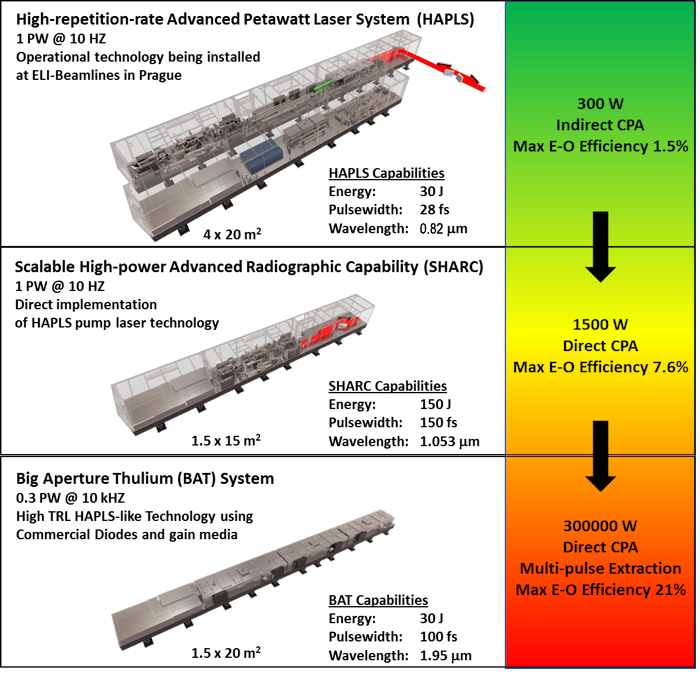Andrew Bayramian (17-ERD-033)
Executive Summary
We are developing and evaluating conceptual designs of short-pulse laser-system architectures for three kilowatt power levels that could serve as future high-average-power, high-energy petawatt systems. Such systems support national security missions and Lawrence Livermore National Laboratory core competencies in lasers and optical science and technology and high-energy-density science.
Project Description
The Lawrence Livermore National Laboratory's petawatt laser (developed 20 years ago) ushered in the relativistic optics regime along with unexpected discoveries such as the production of ions at mega-electronvolt energies that have since become standard probes for high-energy-density science. High-energy short-pulse laser systems have enabled a wide range of new high-energy particle and radiation sources for single-shot research. Practical applications of these lasers require even higher repetition rates and higher average powers beyond the kilowatt barrier to tens (and ultimately hundreds) of kilowatts. Our project addresses the technical challenge of enabling power-scaling short-pulse laser technology to attain average power levels ten to a thousand times higher than is currently possible in order to meet the radiation-source requirements for accelerator, medical, and industrial applications. Achieving this increase in performance requires mitigation of the thermal effects and efficiency limitations of current technology. We are evaluating (1) potential system architectures and materials to identify designs most likely to be successful; (2) gain media; and (3) amplifier pumping and cooling architectures for scaling to higher average power. The development of analytical average-power scaling rules applicable over a wide range of laser architectures will enable understanding of the effects of heating on laser-system performance.
The resultant short-pulse, laser-system architectures could serve as future high-average-power, high-energy-petawatt systems for high-energy-density science research, advanced accelerator applications, and next-generation light-source applications. We will leverage Laboratory-developed modeling codes and practical lessons learned during production and commissioning of the High-Repetition-Rate Advanced Petawatt Laser System to select three architectures producing 3, 30, and 300-kilowatt average power. Employing lessons learned from our recent observations and benchmarking efforts on the advanced petawatt laser will enable improved methods for mitigating thermal effects in the laser amplifier as the power scales. These inputs will shape our analysis of the various amplifier architectures by developing analytical average-power scaling rules applicable over a wide range of laser architectures. We plan to perform detailed analyses of thermal limits and efficiency of selected architectures to set subsystem performance requirements. We will also conduct subscale experiments to provide data for model validation and to identify key risks and mitigations as part of a technological assessment for each candidate architecture. Performing risk-mitigation experiments and updates to the architectures and cost estimates will help develop a technology roadmap for future petawatt laser systems.
Mission Relevance
Our project supports the NNSA goal of advancing the science, technology, and engineering competencies that are the foundation of the NNSA mission. By extending the architecture of Lawrence Livermore National Laboratory's High-Repetition-Rate Advanced Petawatt Laser System and innovating new designs to break through the kilowatt high-energy barrier for petawatt lasers, we are also supporting the Laboratory's core competencies in lasers and optical science and technology and high-energy-density science.
FY17 Accomplishments and Results
In FY17, we (1) assembled a list of candidate materials; (2) built and applied an evaluation tool to assign a figure of merit to the materials; (3) identified two laser systems including materials, architectures, and thermal analysis for further development; (4) developed models to understand dispersion and contrast in these systems; (5) investigated switching technologies needed to make the architectures function; and (6) identified and procured samples of the most promising gain and switch materials for evaluating optical and mechanical details (including detailed cryogenic spectroscopy and laser-damage thresholds) not available in published literature.
Publications and Presentations
Bayramian, A. 2017. "High Average Power Petawatt Laser Systems Enabling the Transition from Proof of Principle Experiments to Commercial Applications." Advanced Lasers and Photon Sources (ALPS) Conference 2017. Livermore, CA: Lawrence Livermore National Laboratory. LLNL-PRES-729681.
Bayramian, A., et al. 2017. "kW Short Pulse Laser Driver Technology." European Advanced Accelerator Concepts Workshop 2017. Livermore, CA: Lawrence Livermore National Laboratory. LLNL-PRES-730848.
Haefner, C. 2017. "Very High Average Power, Single Aperture, Diode Pumped Solid State Laser Solutions for Accelerator Applications and Secondary Source Generation." DOE Office of Science Report on Workshop on Laser Technology for k-BELLA and Beyond. 1-64. LLNL-AR-733300.
Haefner, C., et al. 2017. "kW Short Pulse Laser Driver Technology - Summary." Workshop on Laser Technology for k-BELLA and Beyond. Livermore, CA: Lawrence Livermore National Laboratory. LLNL-PRES-731429.
——— 2017. "The Big Aperture Thulium Laser: Research and Development to Validate Technologies for Petawatt Class, Single Aperture 300kW Average Power Laser Driver for Future Accelerators and Secondary Sources." DOE Office of Science Program Funding Opportunity LAB-17-1779. 1-12. LLNL-PROP-736443.
Siders, C. W., et al. 2017. "Current and Future Directions on DPSSL at LLNL." European Plasma Research Accelerator with eXcellence In Applications (EuPRAXIA) Workshop 2017, DESY, Hamburg, Germany, June 19-23, 2017. LLNL-PRES-733530.
Spinka, T. 2017. "Kilowatt-Class, Application-Enabling Petawatt Laser Technology." UltraFast Optics (UFO XI) Conference 2017, Jackson Hole, WY, October 8-13, 2017. LLNL-PRES-739587.
   





